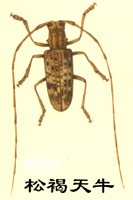The pine longhorned beetle is also known as the pine longhorned beetle and the pine longhorned beetle. Domestically distributed in Hebei, Jiangsu, Shandong, Zhejiang, Hunan, Guangdong, Guangxi, Taiwan, Sichuan, Yunnan, and Tibet, and abroad in Japan. It mainly damages masson pine, followed by fir, spruce, cedar, larch and other weak trees or newly felled trees. In southern provinces, after the masson pine caterpillars weaken the growth of pine trees, the insects invade in large numbers, causing entire pine trees to die. This insect can also transmit a nematode disease that kills Japanese pine trees in large swaths. Pine trees in my country are also seriously damaged by pine wood nematode, and controlling pine longhorn beetles is an important way to control pine nematode disease.

Adult: 15-28 mm long, 4.5-9.5 mm wide, orange to russet. The antennae are brown and maroon, with sparse gray-white hairs on all sections 1 and 2 of the male antennae and at the base of section 3; except for the terminal sections 2 and 3 of the female antennae, most of the remaining sections are gray-white, with only a small ring at the end being dark. . The male antennae are more than twice the body length, and the female antennae are about 1/3 longer. The forechest is wider than long, with many wrinkles and larger side spines. There are two fairly wide orange-yellow vertical stripes on the front and back of the chest, alternating with three black velvet stripes. The scutes are densely covered with orange-yellow hairs. Each elytra has 5 vertical stripes, consisting of square or rectangular black and gray-white fluff spots alternately. There are gray and white hairs on the abdomen and feet.
The eggs are about 4 mm long, milky white, and slightly sickle-shaped.
The larvae are milky white, flat cylindrical, and can reach 43 mm in length when mature. The head is dark brown, the chest and back are brown, and there are wavy horizontal stripes in the center.
The pupa is milky white, cylindrical, and 20-26 mm in length.
Biological characteristics: This insect has one generation per year, and mature larvae overwinter in xylem tunnels. The following year, in late March in Hunan and in May in Sichuan, the overwintering larvae pupate in the pupa chamber at the end of the insect passage. In Hunan, a small number of adults began to emerge in mid-April. After emergence, the adult insect bites a circular eclosion hole with a diameter of 8 to 10 mm to go out and eat twigs and bark as supplementary nutrition. It is active day and night and has weak phototaxis. May is the peak period of activity, and adults are also found to be active and lay eggs in September and October in Guangdong.
After the adult becomes sexually mature, it bites an eye-like groove on the bark of the tree and then lays one to several eggs in it. After hatching, the larvae burrow into the bark. When they are first instar, the larvae feed under the bark, forming wide and irregular pits in the inner bark and sapwood, damaging the tree's transmission system. The pits are filled with brown insect droppings and white fibers. Like moth-like debris. In autumn, oblate holes are drilled into the xylem by 3-4 cm, that is, the tunnel is bored upward or downward. The tunnel is about 5-10 cm long, and then bent outward to feed on the sapwood, and a pupa chamber is built at the end of the tunnel to pupate. The entire tunnel is It is U-shaped. Except for a few left at the end of the tunnel near the pupa chamber, most of the moth debris is pushed out under the accumulated bark. The tunnel is very clean.
The spawning activity of adults requires more light, and the temperature is most suitable at around 20°C. Therefore, it generally occurs more severely in sparse forest stands. In stands with large canopy density, the forest edges are most infected; or from the clearing in the forest first. occurs and then spreads around. If the felled wood is not transported out of the forest in time, left in the forest for the summer, or is not peeled, it will soon be infested by this insect.
animal tags:
We created this article in conjunction with AI technology, then made sure it was fact-checked and edited by a Animals Top editor.